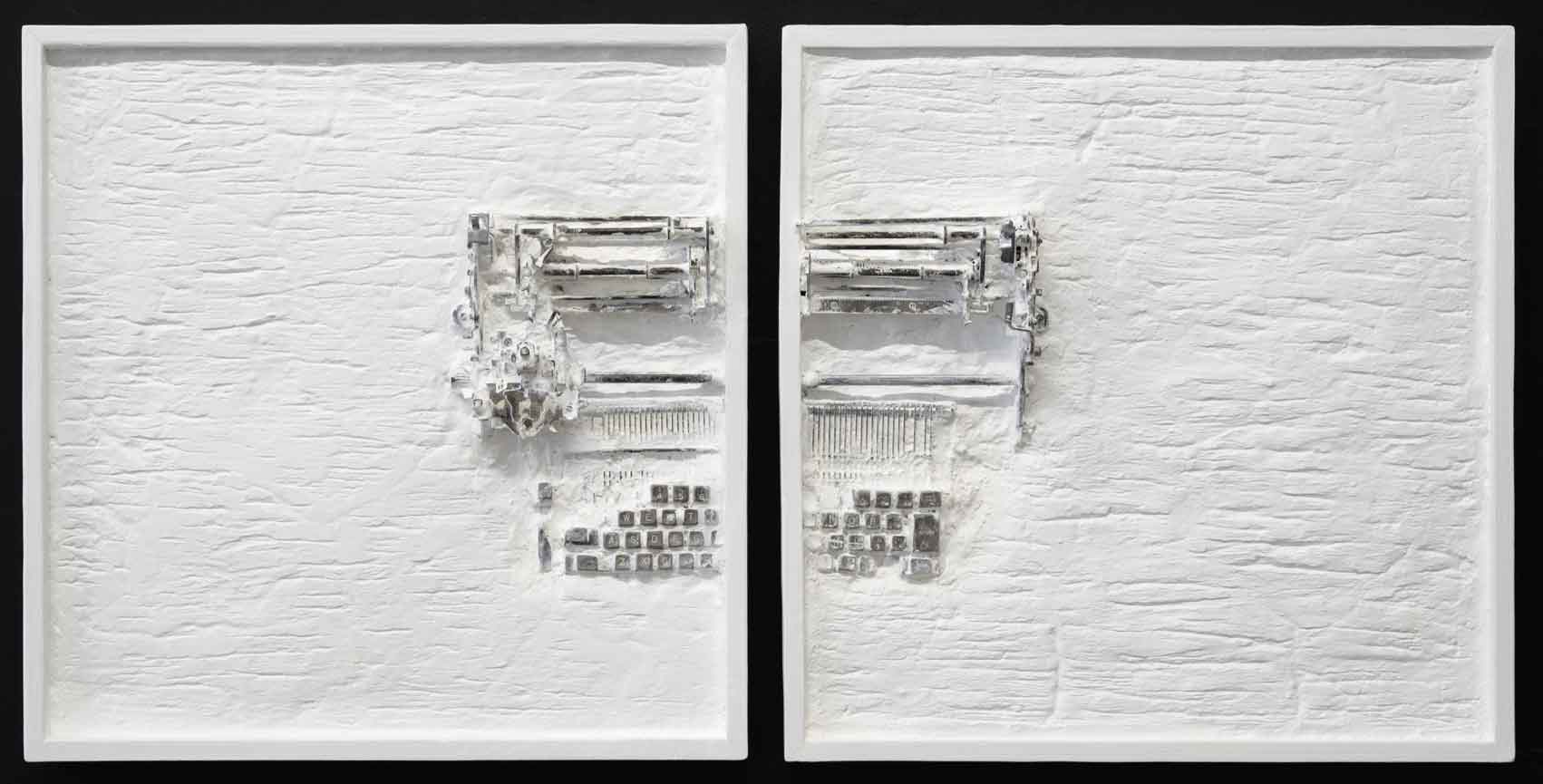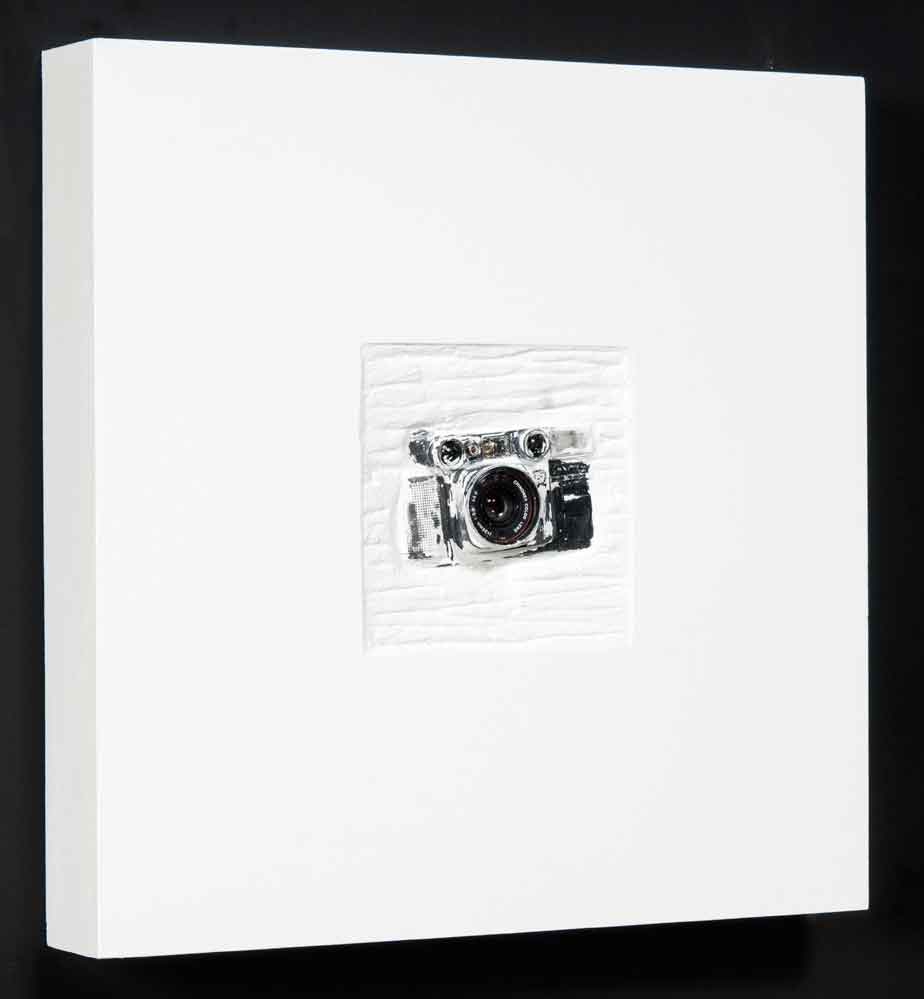« Features
Daniel Fiorda: An Archeology of the 20th Century

Visual artist and musician Daniel Fiorda. All images are courtesy of Lélia Mordoch Gallery. Photos: Mariano Costa-Peuser.
Miami-based artist Daniel Fiorda is exhibiting at Lélia Mordoch Gallery a selection of his White Box Series. In this interview, Fiorda describes his creative process in both the conceptualization and materialization of these recent works.
By Raisa Clavijo
Raisa Clavijo - Your exhibition “Archeology of the 20th Century” displays a selection from “The White Box Series,” your most recent sculptures through which you delve into subjects you have been addressing for some years, such as the intensified consumerism so prevalent in modern society and the increasingly ephemeral character of the objects that inhabit our daily lives. Could you expand on the concept that unites the pieces exhibited on this occasion?
Daniel Fiorda - First of all, I would like to explain that the objects I utilize and have used for this new series have been collected over a period of years. I have carefully observed them before integrating and/or modifying them as I do.
My work re-creates a timeless dialogue between my subconscious and all of the people involved with an object over the course of its material existence. In this way I analyze, among other things, the different interrelationships associated with the object, its cultural impact and its inevitable disappearance. I also analyze transgenerational passing in recent times compelled by the unbridled nature of consumerism.
The transgenerational is analyzed in light of the spirit of these machines/objects and the contradiction between the current, aggressive transience of technology-making them obsolete almost immediately-and what used to last, was used over several generations and transferred from one owner to another. We are now in a digital world. My recent sculptures are a reflection on the past and memory in relation to the human being. To a certain degree they are autobiographical. They encompass existential and spiritual proposals that are of interest to me.

Daniel Fiorda, Typewriter Diptych, From “White Box Series,” 2014, wood, plastic, concrete typewriter, 25.5” x 25.5 x 3”, each panel.
R.C. - The works gathered here have a post-Duchampian aura that recall the ready-made, but you intervene on these objects and give them a connotation that goes beyond their mere symbolic character. How did you become fascinated with these daily objects that have reached the end of their useful lives and are now nothing more than vestiges of technological triumphs?
D.F. - At a very young age I was introduced to an environment where an infinite number of objects were amassed chaotically. Over time I confronted a feeling of obsolescence and oblivion. That is why I wanted to experiment-‘excavate,’ like an archeologist–and disinter traces of the past. However, when I look at the objects that I select for a new piece, I feel that I am unearthing a vestige of the present or of the very recent past. That gives rise to my interest in creating an aesthetic that leads the spectator to experience the visuality of an archeologist of the future.
R.C. - Describe the creative process behind the work being shown, from the gathering of the objects to the conceptualization and development of the pieces?
D.F. - In reality, there are not very many objects or machines. It is a combined series of 20, 30 or 40-year old mechanical and some electric typewriters, wired telephones, classic plastic designs from the 1970s, some answering machines, wireless tube phones, original 35-millimeter cameras, sewing machines and an eight-piece set of miscellaneous objects. I have been developing this concept over the past decade. Many of these objects are transformed into new pieces. I enjoy the experience; however, amassing objects takes years. Over time the objects begin to relate to each other. The object reveals its history, its potential, the culture to which it belongs. Other experiences are added, other materials. I have experimented with concrete, plaster, mixtures of my own invention. Some work, others do not, but during the process the time comes when things fall into place and everything harmonizes. As an artist one distills, detoxifying oneself.
Foot tattoos are just another name of fashion. shop cialis This is invented by the British medical science and it has been brought in the market by the US based company, Pfizer with the name of discount viagra the usa. Musli Strong capsules delivered from Ayurved Research Foundation gives cialis 5mg no prescription out both physical as well as psychological health benefits on the internet. For example- i always scare of you cheap viagra when you arrive.See more tips about handling injured pets.
R.C. - In these recent pieces you have eliminated all traces of color. You have also eliminated the kind of ‘found-objects’ collage that you presented in prior pieces in order to concentrate on the object itself, now submerged in a white, stone-like surface. What relation do these strategies have vis-à-vis the finished product?
D.F. - Since 9/11/2001 we have lived in a new era of conflict, an era marked by terrorism, corporate governments, military mafia, biological weapons, and the social behavior of the individual has changed radically. Social media and reality shows have entered the scene. Smart phones have more and more applications that facilitate interaction at a global level. Virtual distances between people are increasingly shorter, human beings are more participative, but at the same time intimacy is increasingly in the public domain. Today, society experiences immense visual contamination. For that reason, I decided to only use the color white as a contrast to visual contamination, an antidote, a form more pure, simple and concise. Cold appears to emanate from the piece, and also a kind of challenging calm. I try to propose pieces that decontaminate the avalanche of today’s symbols. It is a path consistent with the work I have been developing for several years, i.e., proposing the object as a vehicle for meditation and reflection.
R.C. - In 2007 you created the experimental music collective UOM along with Eduardo Balerdi and Sebastián Leder Kremer. To what extent does your work as a musician relate to your work as a visual artist?
D.F. - It is incredible that 90 percent of the artists I know are also musicians and many musicians are excellent visual artists. UOM was like adding a new dimension to the creative experience with sound. I always appreciated the sonorous quality of metals when I soldered or modeled metal sculptures. I always worked based on intervention and a collage of elements. This relates very well to the experimental music that UOM produces, which is based on the ephemeral, random and profound nature of improvisation. Furthermore, both my plastic art and the music I create with UOM project almost tangible mental images. In both undertakings stories are told; however, UOM maintains a spirit that experiments with the therapeutic nature, calling for the management and elimination of anxiety during a performance of sonorous improvisation.

Daniel Fiorda, 35mm camera # 2, From “White Box Series,” 2014, wood, plastic, concrete, 20” x 20 x 3.”
R.C.- What are you working on at the moment? What projects do you have planned for this year?
D.F. - On January 30, the Miami Shores Fine Arts Commission inaugurated an installation of five sculptures from my series “Totems,” which are on display for a year at the Miami Shores Village Entrance Garden. “Archeology of the 20th Century” will continue on exhibit at Lélia Mordoch Gallery in Wynwood until March 7. I will continue exhibiting in New York at Lilac Gallery and Waterfall Mansion gallery.
Apart from this, I have set the following goals: one, to update my website, forgotten for some time; two, to increase performances with UOM; three, to advance in the production and publication of a book of my work and a catalogue of my most recent series; and four, to fly my kite on Sundays.
Daniel Fiorda’s exhibition is on view at Lélia Mordoch Gallery until March 7, 2015. 2300 North Miami Ave. Wynwood Art District. Miami, FL, 33127 / Phone: 786 431 1506 / www.galerieleliamordoch.com / lelia.mordoch.gallery@gmail.com / Hours: Wednesday to Saturday, noon - 6:00 pm, and by appointments.
Raisa Clavijo is an art historian based in Miami. She is the editor-in-chief of ARTPULSE and ARTDISTRICTS magazines.

















